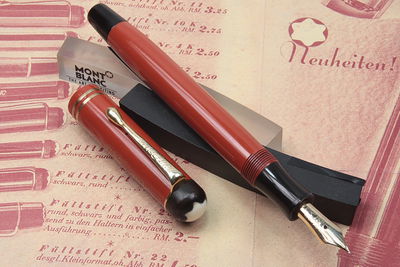Fountain pen
The fountain pen is probably the most elegant and refined among writing instruments. For a long time considered old-fashioned, and now replaced by modern ballpoint pens, markers and roller, today is recovering a deserved rematch with the emergence of renewed interest in this tool so unique and personal.
A short fountain pen history
Although the begin of writing instruments history is lost in the mists of time, the fountain pen has no more than two centuries. Although there are traces of reservoir pens up from the tenth century, [1] when the sultan of Egypt commissioned a pen that should not make stains on hands and clothes (which is still continues to happen) and was brought a pen with a tank, forerunner of modern fountain pens. But the first examples at least partially functioning fountain pens are dating approximately to the half of 1800, and only at the beginning of last century the fountain pens has actually become a reliable writing instrument.
For many centuries in fact the main writing instrument was the goose pen, until the use of metal nibs began to spread in mid of nineteenth century. Although they were an important innovation, metal nibs presented the inconvenience of the need of a continuous ink retip. For this reason, in the era of the industrial revolution, people began almost immediately to try to equip the nibs of some form of tank to solve this problem. These first attempts, however, always worked in an occasional and poor reliability.
There are various precursors of what today is called a fountain pen, the most important of which, the first for which a patent is known (dated May 25, 1827) is probably the one created by Petrache Poenaru for a portable pen supplied with a sort of cartridge consists of a cylinder made from a quill pen. These first attempts, however, never knew a big spread, probably because their functioning still not reliable enough.
Therefore, despite the existence of various precursors, many people set the birth date of the modern fountain pen in 1883, when Lewis Edson Waterman, with the invention of the multichannel feeder, began the production of what is considered to be the first truly functional and reliable pen. This is only a partial truth, because many other functional fountain pens were produced at that same time, but is true that the Waterman invention was an important improvement, as well its contribution to the industrialization of production.
Since then the fountain pen experienced a period of great improvements, in the materials, in the filling systems, and also in style and design. In particular the period between the '20s and '50s is considered to be the golden age of fountain pens. Starting from the '60s, with the pervasive diffusion of cheap ballpens, the use of fountain pens has been decreasing. Today we assist to a new peak of interest in fountain pens because they had the characteristic of being very personal objects, capable to give uniqueness and distinction to any people writing.
- ↑ as reported in the article A history of pen showing the translation of an Egyptian document around 969.
How to use a fountain pen
Using a fountain pen may seem the most natural of things to those who are used to it, but for those who are approaching this writing instrument for the first time, some indications may be useful to make up for the lack of experience, and to avoid those errors that can lead to improper, uncomfortable and unsatisfactory use.
Learn more
Take a visit to our main page, or ask on the forum associated with this site (registration is free and consultation completely open and available to all, as the contents this site).
